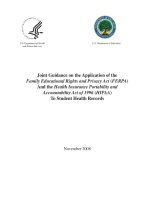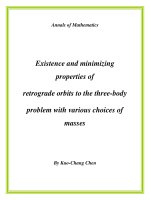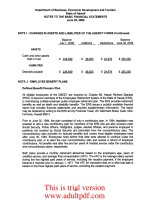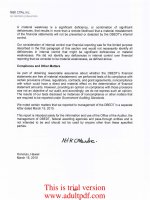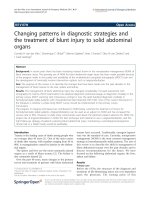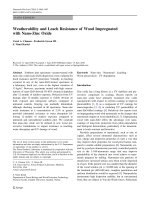Thermal combustion and oxygen chemisorption of wood exposed to low temperature long term heating 7
Bạn đang xem bản rút gọn của tài liệu. Xem và tải ngay bản đầy đủ của tài liệu tại đây (64.05 KB, 11 trang )
Chapter 7: Conclusions
________________________________________________________________________
204
Chapter Seven: Conclusions
7.1 Overview of work done
In this study, works have been conducted to formulate a drying model that is
suitable to examine low-temperature, long-term heating of wood. Specific considerations
have been given to evaporation occurring at the different phases of heating, liquid water
movement in the porous medium and the combined diffusivity of both liquid and vapour
transport on the temperature distribution in the low temperature heating of hygroscopic
wood.
The role of water in the spontaneous combustion of wood was examined in the
thermophysical framework of heat conduction; its effects were evaluated in terms of
thermal conductivity, diffusivity, specific heat, latent heat of evaporation and heat of
wetting. An analytical model incorporating the moisture-mediated thermophysical terms
based on heat conduction provides a framework to examine the experimental results on
heating and ignition properties of green and preburn wood, each case representing the
different degree of moisture and thermophysical values. For preburn wood, it was
preheated in oven to produce an average 52 % of preburn (i.e. 48% unconverted virgin
mass). The partially charred wood has halved its moisture content to 6.65% as compared
to 13.83% of oven-dry green wood, and contained reduced specific heat capacity and
thermal conductivity.
Chapter 7: Conclusions
________________________________________________________________________
205
Oxygen chemisorption was carried out to investigate the propensity of self-ignition of the
low-temperature, long-term preheated wood chars. Separate parameters of testing and
evaluation model of reactive sites were carried out to elucidate the chemical reactivity of
this amorphous cellulosic chars. Oxygen chemisorption provides a chemical viewpoint to
in addition to thermophysical approach to examine self-heating and spontaneous
combustion of low-temperature, long-term preheated wood, targeted to minimize
unwanted fires arising from the wood structures and construction in historical and
modern buildings.
The next section presents the conclusions and contribution of knowledge to the
thermal combustion and propensity of preheated wood chars exposed to low-temperature,
long-term heating. Recommendations are proposed therein with the respective research
findings.
7.2 Conclusions and Recommendations
The research findings contribute to the body of knowledge on thermal combustion
and oxygen chemisorption of wood in the following areas: evaporation, liquid water
transport, role of moisture in thermal combustion and oxygen chemisorption.
Chapter 7: Conclusions
________________________________________________________________________
206
7.2.1 Evaporation for low-temperature drying
The study found that for low-temperature, long-term heating of wood, a different
approach towards evaporation is required in the construction of a heating model. The
study indentified that for low-temperature heating model, the following key research
findings that contributed to the understanding of low-temperature drying
phenomenological modelling: -
• For the initial drying phase of low-temperature drying with low heating rates,
evaporation occurred at the boundary. Hence, evaporation term was removed from
the energy balance for the low drying model. The simulated temperature-distance
curve produced a uniform temperature distribution throughout the volume, which
would be more realistic for the initial heating phase rather than an exponential
temperature-distance time curve. The study showed that re-formulation of
evaporation at the boundary produced temperature distribution that concurred well
with theoretical proposition for initial drying, where the large moisture content and
water diffusivity contributed to a rather uniform temperature distribution within the
domain.
• For prolonged drying, it was necessary to re-introduce the evaporation term into the
energy balance as evaporation front has retreated into the domain. Equilibrium
approach was chosen over the non-equilibrium approach to formulate the rate of
evaporation for the case of low-temperature, extended drying phase. The simulations
Chapter 7: Conclusions
________________________________________________________________________
207
results clearly demonstrated that equilibrium water-vapour assumption was more
suitable for low-temperature, prolonged drying of wood than a fast heating scenario.
This was because the extended low temperature, constant heating of wood cubes at
200°C, coupled with moderate equilibrium moisture content of 14%, permitted the
vapour pressure to reach equilibrium in both real time and over surface zones, where
fast vapour convection would have perturbed the balance of water-vapour equilibrium,
defying the equilibrium assumption which did not consider the rate limit. The
simulations illustrated the heat sink effect of an internal evaporation term.
• Future work: the findings from this study suggested that long-term heating could
continue to adopt the equilibrium approach for water evaporation given the low
temperature range and extended time. The use of non-equilibrium approach would
however improve the accuracy in terms of modeling the transition of non-equilibrium
to equilibrium states. However, measurement of vapour pressure in a small domain in
a dynamic environment would be necessary to formulate the rate of evaporation to
match the actual attainment of equilibrium time if the non-equilibrium approach is
used. More accurate dynamics measurement methods for vapour pressure in porous
media would also be required.
7.2.2 Liquid water transport
To evaluate the effects of moisture transport on thermal combustion, this study
found that free water movement should be modeled at the low temperature wood drying.
Chapter 7: Conclusions
________________________________________________________________________
208
A porous model was proposed to consider free water movement. The research findings
established key findings pertaining to the use of porous model and the effects of moisture
transport on thermal combustion as follows: -
• The porous slab was modeled by physical addition of momentum sink to the transport
equations in a conservation model. It offered a useful method to use heat and mass
transfer governing equations for examining flow in porous structure. The use of
discrete pore model approach to study porous slab would not be able to incorporate
governing equations that are built on the assumption that all phases are continuous.
Darcy’s law in the porous medium was modified to account for the effect of
boundaries on the flow field and the inertial effects associated with the flow.
• The impact between free water movements on the development of temperature field,
examined using the porous model, showed a strong correlation. Free water movement
was slow and stable at the longitudinal cross-sections measured at the centre, 20mm
measured from surface and surface boundary. The coupled velocity of free water and
temperature field development in the initial phase did not produce any significant
temperature rise in the heating of wood cube. Free water movement at initial heating
phase, when subjected to constant heating regime did not affect the spontaneous
combustion of wood.
• For extended drying, the strong correlation between fluid flow and the temperature
distribution illustrated the importance of fluid movement on temperature field
Chapter 7: Conclusions
________________________________________________________________________
209
development. Stronger fluid movement at low temperature, prolonged heating
enhanced temperature development, partly explained the spontaneous combustion
observed in the wood cube after being exposed for 9 hours in the isothermal oven.
The results endorsed Babrauskas (2001) proposition that fluid flow has a deleterious
effect on thermal stability, where spontaneous heating occurs more readily in wet
than dry wood.
• Limitations: The drying model with internal evaporation successfully modeled fluid
flows in terms of a combined moisture and vapour approach. The combined fluid
flow was introduced to overcome the problem of unknown transition rate between
non-equilibrium to equilibrium between water to vapour, as equilibrium approach
assumed instantaneous equilibrium without rate limit. However, the use of combined
diffusivity would not be able to differentiate between two types of moisture, and
hitherto not able to provide information on the changes in each physical phase.
• Future work: For detailed modeling of flows in the heating of wood, both vapour and
liquid water need to be considered. However, correct modeling of vapour pressure or
vapour equilibrium state is critical to the separate modeling of vapour and liquid
water. More work could be done to improve the theoretical knowledge of phase
change between water and vapour in the heating process. Further work could be
carried out to investigate the interaction between convection and chemical reaction
which impacts on the development of the concentration and temperature fields. In
Chapter 7: Conclusions
________________________________________________________________________
210
future models that consider chemical reactions such as pyrolysis, the influence of
convection on the development of chemical reaction can be examined.
7.2.3 The role of moisture in thermal combustion
Thermal combustion, introduced by the Russian school (Zeldovich and Frank-
Kamenetskii 1938, Frank-Kamenetskii 1969) which has been systematically adopted in
the study of spontaneous combustion, is based solely on the consideration of pure heat
conduction, without considering the thermodynamics of moisture effects. This study
incorporated moisture-mediated thermophysical properties within a revised thermal
model to examine the role of moisture from thermophysical viewpoint. The study
established some important findings for thermal combustion model as follow:
• Pure heat conduction model produced larger values of surface temperature at ignition
T
ig
than the thermocouple-measured values for green wood. At high heat fluxes ≥
20kW/m
2
, the pure heat conduction model yielded exceedingly high temperatures
ranging from 430°C to 465°C. The revised analytical model incorporating moisture-
mediated thermophysical terms, however was able to produce surface temperatures
that were in better fit with the experimentally measured surface temperatures. The
significance of moisture in thermophysical terms can also be illustrated by the results
obtained from the preburn wood samples. The good agreement in both the computed
values with measured temperatures in preburn wood can be explained in terms of
reduced moisture, which lowered the values of thermophysical properties.
Chapter 7: Conclusions
________________________________________________________________________
211
• This study has proposed the use of complimentary error function
erfc
β
for
1
β
and complimentary function
erf
β
for
1
β
in the calculation of cooling modulus.
The proposed change yielded good results for piloted ignition of both green and
preburn wood. However, the revised thermal model could not accurately predict the
surface temperatures for spontaneous ignition mode, particularly for green wood. This
was because without the presence of pilot to provide the energy to ignite the
combustible-gas mixture, flaming occurs entirely upon the attainment of sufficient
surface temperature; hence, moisture, other than its effects on thermophysical terms,
must have acted thermodynamically to affect the ignition of green wood.
• This study experimentally yielded a lower critical heat flux at 11kWm
-2
for green
wood, and 12kWm
-2
for preburn wood, when measured up to 2 hours for green wood
and ¾ hour for preburn wood. These experimentally derived critical heat fluxes are
lower than the stipulated design value of 12.5 kWm
-2
obtained for correlation of
ignition times less than 20 minutes duration. For green wood, theoretically
extrapolated
cr
q
′′
derived using
1/
ig
t
vs.
e
q
′′
is within 10% of the measured minimum
heat flux of 11kW/m
2
. The extrapolation using
/
e ig
qt
′′
vs.
e
q
′′
is around 20% of the
measured minimum heat flux. The results suggest that the data for thick fuels should
be examined by plotting
1/
ig
t
vs.
e
q
′′
. However, both extrapolation methods did not
yield as good a proximate critical heat flux for piloted ignition preburn wood as
compared to that of green wood, when judged using the 10% rule.
Chapter 7: Conclusions
________________________________________________________________________
212
• Future work: It could be possible to further elucidate an even lower critical heat flux
following the introduction of the new class of potential hazard of preheated wood.
However, more work is need to elucidate the mechanisms, both experimental and
theoretical, that cause the ignition data at lower heat fluxes to deviate from that
obtained in high fluxes. A secondary trend still dominated at the lower heat fluxes for
both green and preburn wood using thermal correlation. A better physicochemical
understanding is required to address the secondary mechanism before any extended
correlation could be realisable.
7.2.4 Oxygen chemisorption
To evaluate the propensity of self-heating, gas-solid reactions provided the
chemical viewpoint in addition to the thermophysical modelling studies. The key findings
pertaining to oxygen chemisorption, the reactivity, and changes in chemical functional
groups of preheated wood chars were listed as follow:
• Oxygen chemisorption largely conformed to Elovich kinetics. Because of the low
heat treatment temperature, wood chars were invariably very reactive. Only wood
chars tested at low chemisorption temperatures equal and below 140°C could be
interpreted for the full run for chemisorption. Cellulosic char created at 300°C at
partial pressure of oxygen
2
160mmHg
O
p =
has compatible reactivity as that of more
graphitic, well carbonised chars found in other studies such as brown coals char
Chapter 7: Conclusions
________________________________________________________________________
213
(tested at
2
380mmHg
O
p =
) and pure carbon (tested at
2
760mmHg
O
p =
) temperature
range from 110°C to 155°C. The changes in oxygen partial pressures did not
significantly affect the rate of chemisorption as temperature did. Cellulosic wood
chars reported activation energy of 16 kcal/mol for chemisorption. The apparent
activation energy in cellulosic wood chars showed that there are different types of
active sites responsible for chemisorption in wood chars and that of the more mature
and graphitic carbon chars. Different theoretical models are needed to understand
chemisorption and combustion behaviours of cellulosic wood chars from coal chars.
• Contrary to the popular belief that only inert-heated chars are capable of
chemisorption, this study found that air-preheated wood chars at 150°C for 30days
also showed some weight gain due to gases adsorption, and thereafter ensued by a
precipitous weight loss, indicating ignition. For air-preheated wood chars heated at
140°C for 50 days, chemisorption occurred after some period of isothermal heating,
leading to rapid gasification at the end of the chemisorption run. Nonetheless, there is
no conclusive evidence at this point to predict as to when chemisorption might occur
in air-preheated samples, and if ignition might take place at all, unlike inert-heated
samples where chemisorption is immediate upon exposure to oxygen and in certain
cases, leading to ignition of wood chars at low temperature.
• Fourier-transform Infra-red Spectroscopy showed that the low temperature chars
prepared at 140
o
C and 150
o
C for both types of woods in general have very similar
chemical composition with the fresh wood samples, except that these char samples
Chapter 7: Conclusions
________________________________________________________________________
214
contained higher concentration of carbonyl groups at around 1700 cm
-1
. Hydroxyl
groups (3600-3300 cm
-1
) were progressively eliminated as charring temperature
increased. These groups were totally eliminated in wood char samples when heated at
200°C for 9 days. The study showed that wood chars that exhibited increased
propensity for self-ignition were those heated at 140°C and 150°C. The heat treatment
temperature at 200°C therefore sets the upper limit on pyrophoria of wood chars
because the primary hydroxyl group responsible for reactivity of wood chars was
preferentially oxidized
• Lower ignition temperatures have been found for the long-term air-preheated wood
char samples in this study. The Semenov model of thermal ignition analysis showed
that the different ignition temperatures, which arose from a combination of different
preheating duration and heat treatment temperature were almost kinetically
comparable. Despite the fact that chemisorption led to a lower ignition temperature,
the observed range of lowered ignition temperatures was not kinetically significant on
wood pyrolysis, neither did the change in ignition temperature suggest a switch in
pyrolysis pathway in wood decomposition.
• Future work: To further elucidate the carbon-oxygen reaction, temperature-
programmed desorption studies could be carried out to study the transient rates of
consumption of oxygen and production of CO
2
and CO. The role of water content in
wood char oxidation can be further investigated to expound the interaction between
water and chemisorption in wood char.
